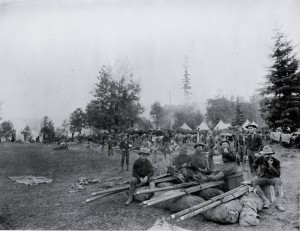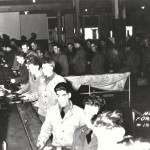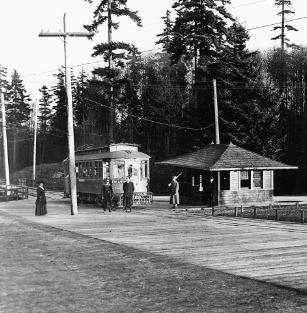Then…
In the late 1800’s, it was a fervent hope that Fort Lawton would bring on an economic boom. Members of Seattle’s rich and elite founding fathers, worked hard through the Seattle Chamber of Commerce to get it established and filled with soldiers. From 1886 when the idea first emerged, to 1895 when legislation was tried as a way to obtain it, to February 1898 when a second designation making it an official Fort, finally stuck, men like Thomas Burke, John Leary and Edward Graves played politics and moved and shook to get the Fort established. This involved a complex plan to get the land to the army at no cost to them. It is frequently said that the land was donated. It was, in fact, traded for some public school lands in Ballard to the individuals that had claimed the land in the area that would become the Fort.
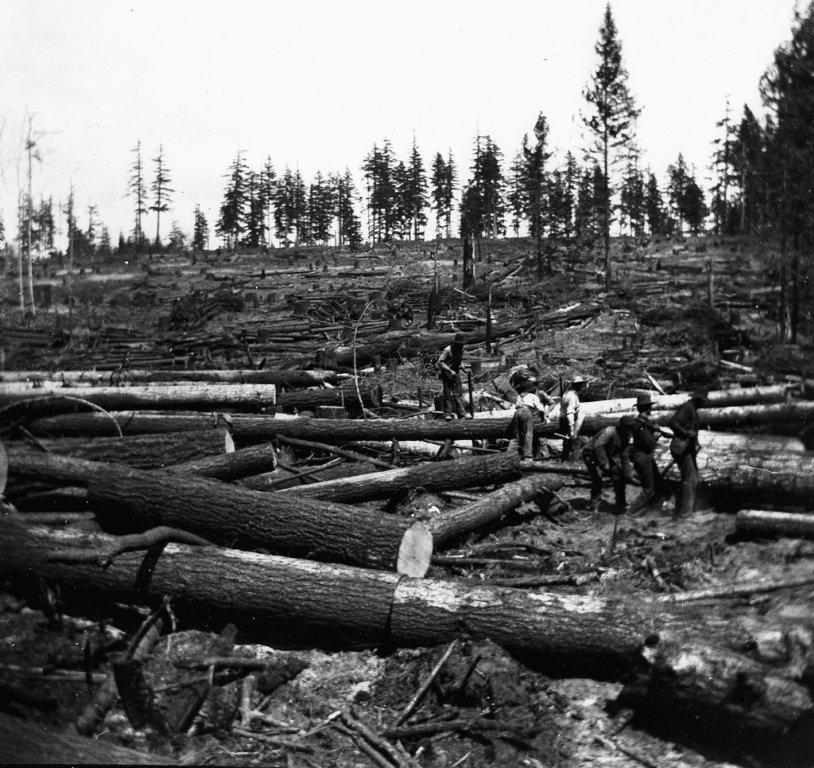
Men clearing timber to build Fort Lawton. Seattle Department of Parks and Recreation, Discovery Park Photographic Archive, #N-124. Circa late 1890s.
In the end, the Fort was established for 2 reasons, according to Magnolia: Making More Memories, to protect the City of Seattle from lawlessness – “The governor of Washington Territory, Watson Squire, was publicly in favor of this. He had had to evoke martial law in Seattle as a result of the anti-Chinese rebellion of late 1885 and early 1886, which pitted out-of-work locals living during a significant economic depression against the wealthy citizens who wanted Chinese workers for their cheap labor. The anti-Chinese mob went after the wealthy City leaders. Squire, one of the five wealthiest men in the district, was uncomfortable. This lawlessness somehow translated in the minds of the City elite into the concept that a fort would be helpful in quelling any future such citizens’ rebellion.” And, to be a coastal defense for the Bremerton Naval Base after it was established.
The complete history of Fort Lawton is one of dramatic turns and unfilled expectations:
“Fort Lawton never lived up to the Seattle Chamber of Commerce’s hopes that the Fort would be a major military complex. For some, the fact that Fort Lawton did not become an important part of the coastal defense reduced its historical significance. For others, never reaching garrison status and being used in a limited fashion meant failure. However, few American military posts have played central roles the way, for instance, Fort Sumter and the Pentagon have done,” as David Chance pointed out in “The Evolution of Intent at Fort Lawton”, “most military engagements have occurred away from posts, rendering forts most useful as supply and processing facilities. And, in that role, this history will prove that Fort Lawton succeeded spectacularly.”
Throughout the history one sees the early and constant mentions of a park or the park-like setting at this site.
“Quartermaster Captain W. W. Robinson, Jr., arrived in Seattle in July of 1896 to make preparations for construction of the new post. The quartermaster reported back to Washington, D.C.: ’This ground will command either a comprehensive view of that portion of the Sound in this vicinity, or beautiful vistas thereof, through such ornamental trees as shall be allowed to stand on the ground, between the post site and the edge of the Bluff to the westward, and also a view to the north and northeast of Salmon Bay valley, Ballard, North Seattle, and the distant Cascade Range. It will afford views from some of the quarters, of the Olympic Mountains to the westward and the Cascades to the north and northeast.” (Magnolia: Making More Memories) Chance comments: “It was as though Robinson were designing a park.” And next, came the report and design by John Olmsted, famed parks planner and landscaper, for the Fort.
The bi-polar downs and up of historical fact of this Fort tell an interesting story:
“The Fort opened on February 9, 1900 on a 1,100 acre site, which was redesigned in 1902 for infantry use [that did not materialized and became an artillery coastal post with hardly any guns]. In 1910, a design overhaul, to include housing for officers and enlisted men, was prepared by landscape architect John C. Olmsted. In 1938, the Army offered to sell Fort Lawton back to the city of Seattle for one dollar, but the city declined, citing maintenance concerns.
At least 20,000 troops were stationed at Fort Lawton at a time during World War II, with over 1 million troops passing through both before and after the war. The post was also used as a Prisoner of War (POW) camp, with more than 1,000 Germans imprisoned there [one dead by confusing circumstances – an odd suicide and is buried in the Fort cemetery]; and, approximately 5,000 Italians passing through en route to Hawaii for imprisonment. On August 15, 1944 an Italian POW, Guglielmo Olivotto, [also buried at the Cemetery] was found murdered at Fort Lawton after a night of rioting between Italian POWs and American soldiers. Twenty-eight African-American soldiers were later court-martialed [the longest court martial of that War], convicted of the crime and sent to prison [head prosecuting attorney was Leon Jaworski later gaining much fame in the implication of Nixon in the Watergate scandle]. The convictions were set aside in 2007. A formal army apology ceremony was held on July 26, 2008 and to present to the relatives of former soldiers and the two remaining survivors years of back pay following the overturn of their dishonorable discharges.”
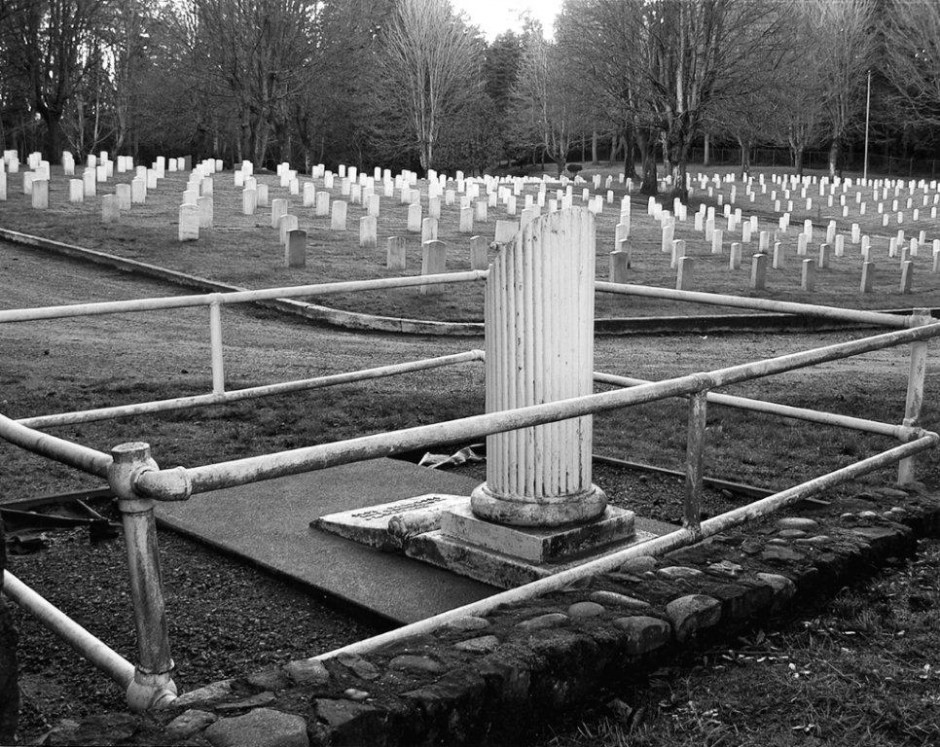
The grave of Italian prisoner of war Private Guglielmo Olivotto, who was reportedly lynched in 1944, lies apart from those of American soldiers in the cemetery at Fort Lawton.
Now…
Fort Lawton has been with Magnolians for 114 years. As of February 25th, the day of the final closure ceremony, the only remnants will be the Cemetery, Fort Historic District, a preserved but privatized Officer’s Row and Non Commissioned Officers quarters. The Veteran’s Center resides in the newest and last building built – the Leisy Center. It will be the only legacy that will remain of the124th Reserve Command (ARCOM). And, our spectacular Discovery Park, the largest Seattle City Park “… an open space of quiet and tranquility away from the stress and activity of the city, a sanctuary for wildlife, as well as an outdoor classroom for people to learn about [and discover] the natural world.” –which will celebrate its 40th anniversary later this year.
Sources: “The Evolution of Intent at Fort Lawton”, David Chance, 1984; Magnolia Making More Memories, “CHANGE, THE ONLY CONSTANT: FORT LAWTON”, Michael Davis and Monica Wooton, 2007, Magnolia Historical Society; Wikipedia; http://en.wikipedia.org/wiki/Fort_Lawton February 20102; City of Seattle, Seattle Parks and Recreation, Discovery Park home page: www.seattle.gov/parks/environment/discovparkindex.htm
